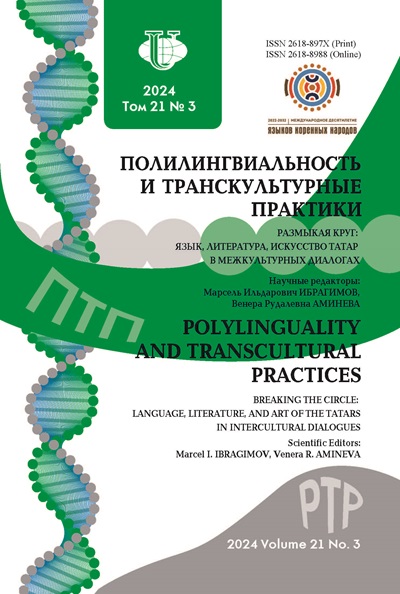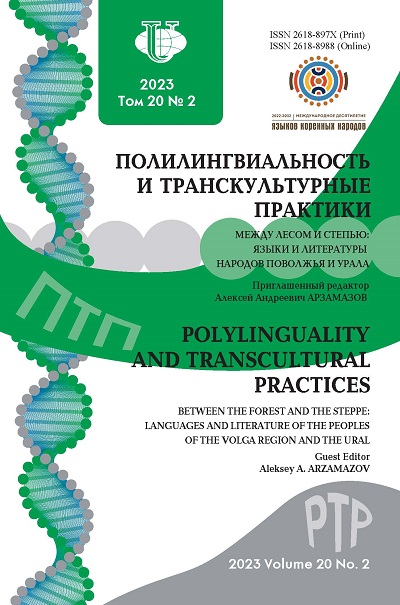Erzya Poetry in the Ural Region: the Artistic World of Dmitry Taganov
- Authors: Arzamazov A.A.1
-
Affiliations:
- Kazan Scientific Center of the Russian Academy of Sciences
- Issue: Vol 20, No 2 (2023): BETWEEN THE FOREST AND THE STEPPE: LANGUAGES AND LITERATURE OF THE PEOPLES OF THE VOLGA REGION AND THE URAL
- Pages: 346-357
- Section: LITERARY SPACE
- URL: https://journals.rudn.ru/polylinguality/article/view/35218
- DOI: https://doi.org/10.22363/2618-897X-2023-20-2-346-357
- EDN: https://elibrary.ru/LEKHFA
Cite item
Full Text
Abstract
The article deals with the problematic and thematic contexts of the work of Dmitry Taganov, one of the most prominent representatives of modern Mordovian (Erzian) literature. D. Taganov, who was born and lives in the Ural region, personifies the literary diaspora of the Mordovians with his biography and poems. In the course of the study, it was found out that his poetic world is distinguished by an ascetic figurative system and a stable set of figurative and symbolic elements, which almost does not change from collection to collection. The study included not only original texts in the Erzya language but also Russian interlinear translations made by the author, which allow interpreting artistic features and stylistic details in two linguopoetical “projections” at once. It has been established that in his poems D. Taganov mostly avoids the actualization of the ethno-cultural component, prefers ethnically neutral lyrical plots, and pays increased attention to the psychological realities of love existence. Some motif-figurative elements connected with the poet’s professional activity in medicine are shown. An important aspect of this study is the analysis of literary translations of D. Taganov’s poems into Russian. Difficulty in understanding the original works by the translator and facts of inattentive attitude to the core parameters of the original text are demonstrated on the example of texts.
About the authors
Aleksey A. Arzamazov
Kazan Scientific Center of the Russian Academy of Sciences
Author for correspondence.
Email: arzami@rambler.ru
ORCID iD: 0000-0001-7577-5917
Doctor of Philology, Head of the Laboratory of Multifactorial Humanitarian Analysis and Cognitive Philology
2/31, Lobachevsky st., Kazan, 420111, Republic of Tatarstan, Russian FederationReferences
- Antonov, Yu.G., Karpov, N.V. 2022. “The motif-imaginative world of the lyrics of Dmitry Taganov”. Yearbook of Finno-Ugric Studies 3: 462–469. DOI: https://doi.org/10.35634/2224-9443-202216-3-462-469 (In Russ.).
- Zav’yalov, S.A. 2007. “Through the Moss of Silence: Poetry of East Finnish Ethnofuturism”. Novoe literaturnoe obozrenie 85: 339–353. (In Russ.).
- Ibragimov, M.I. 2018. National Identity of Tatar Literature: Modern Research Methods. Kazan: IYaLI im. G. Ibragimova publ. Print. (In Russ.).
- Katorova, A.M. 2013. “The main directions of development of Mordovian literature at the beginning of the XXI century”. Vestnik NII gumanitarnykh nauk pri Pravitel’stve Respubliki Mordoviya 1 (25): 122–131. (In Russ.).
- Manaeva-Chesnokova, S.P. 2004. Artistic world of modern Mari poetry: monograph.YoshkarOla: MarNIIYaLI publ. Print. (In Russ.).
- Naldeeva, O.I. 2012. Genre system of Mordovia poetry: genesis, evolution, poetics: monograph. Saransk: Mordovian State Pedagogical Institute publ. Print. (In Russ.).
- Ostapova, E.V. 2016. Komi literature in the mirror of translation. Syktyvkar, Syktyvkarskii gosudarstvennyi universitet im. Pitirima Sorokina publ. Print. (In Russ.).
- Safiullin, Ya.G. 2021. From Romanticism to Comparison of Literatures. Kazan: IYaLI im. G. Ibragimova publ. Print. (In Russ.).
- Sultanov, K.K. 2019. Refraction angle. Literature and identity: the communicative aspect. Moscow: IMLI RAN publ. Print. (In Russ.).
- Khuzangai, A.P. 2017. Without illusions: my temporary. Cheboksary: Chuvashskoe knizhnoe izdatel’stvo publ. Print. (In Russ.).















